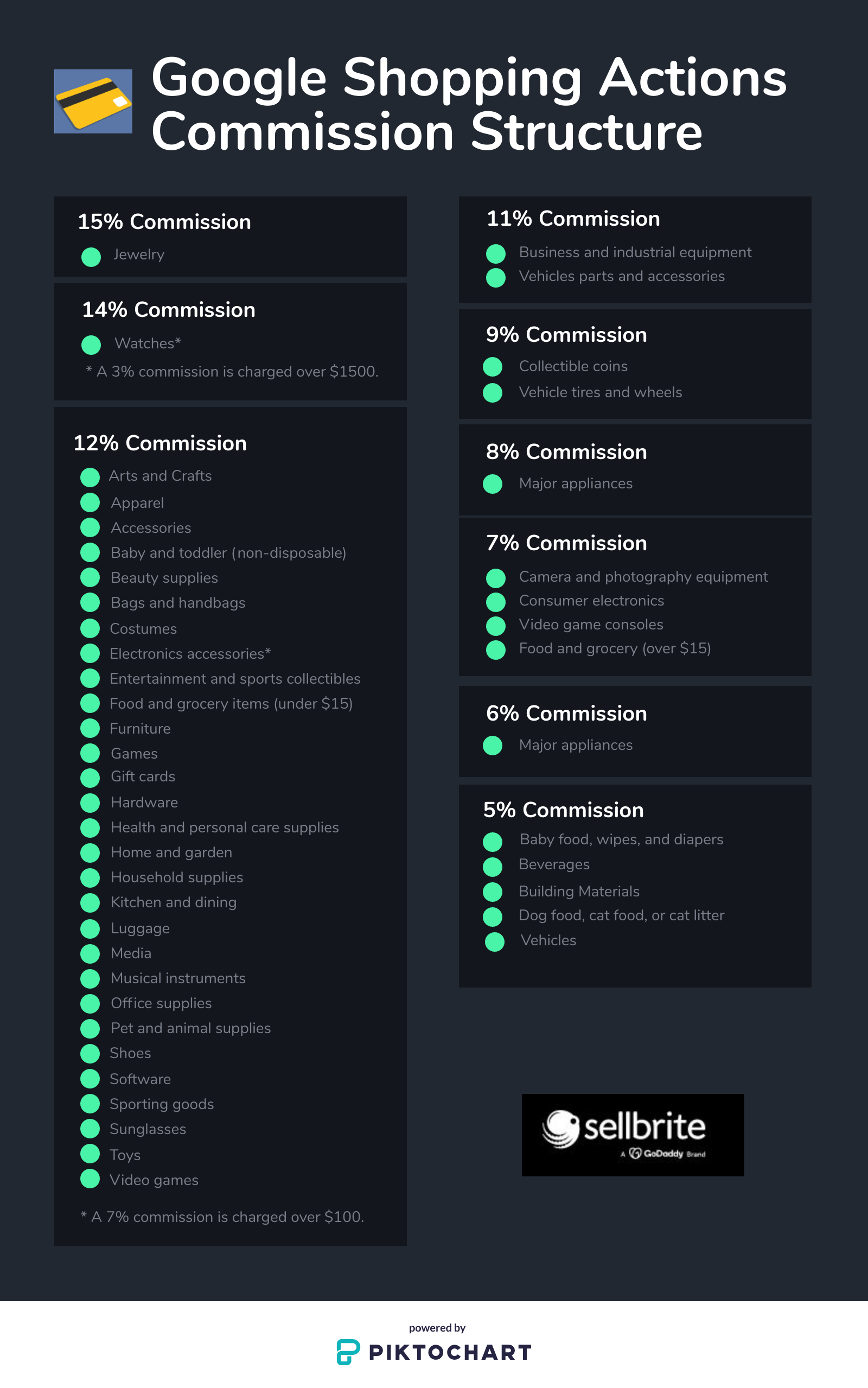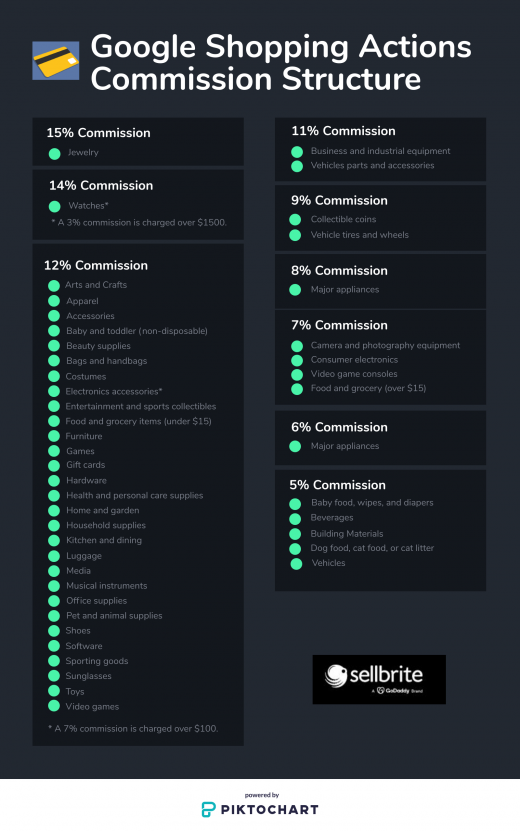How Much Does It Cost to Use Google Shopping Actions?
Google Shopping Actions puts your listings a click away from Google’s main search page — but not without a price.
So exactly how much does it cost to use Google Shopping Actions? Let’s dive in.
The platform lets shoppers buy products from multiple companies, sites, or brands from the same universal cart. Users do a Google search for the products they need — leather jacket, PS4 controller, scented candles — and can buy them all without leaving Google’s website. Retailers benefit from increased exposure (and potential sales) but make a tradeoff with traffic to their site and Google’s commissions.
If you’re looking to try out Google Shopping Actions and expand your listings, we’ll walk you through the commission structure of Google Shopping Actions.
Google Shopping Actions Has No Upfront Cost
How much does it cost to use Google Shopping Actions? It depends on what you’re selling, how you’re selling it, and your online retailer reputation. There are no upfront costs for using Google Shopping Actions, but it does take a commission on confirmed sales.
Google Shopping Actions doesn’t charge per click, and it doesn’t charge to place a listing. You’re thinking of Google Ads. There’s also no monthly fee, though you do need a Google Shopping / Merchant Center account to use the service. Instead, Google Shopping Actions charges only for confirmed product sales.
Google Shopping Actions takes a commission from all products bought in their universal cart. This commission is charged to you, the retailer, at the time of purchase. The average commission is around 12% — this puts Google’s average commission three points below Amazon’s affiliate program (which typically charges 15% on average).
Now, that’s just an average. Google Shopping Actions actually breaks the commission down at the top level by product (and later by retailer score, though we’ll get into that later down the page). In order to calculate the cost of Google Shopping Actions, we have to take a look at a product/commission breakdown, which we’ve provided below.
Google Shopping Actions Commission by Product Category
We’ll break down commission rates by product category, going from the highest commission to the lowest.

If your product doesn’t fit into any of these categories, you’ll be charged the standard 12% fee. However, this list isn’t the end of understanding the cost of Google Shopping Actions.
It’s possible (and likely) you’ll be able to get a discount on those commissions. Your success in grabbing this discount will depend on what kind of seller you are.
Google’s Incentive Program Discounts Commission
The standard commissions listed above can be lowered by meeting certain requirements. Google calls this their “retailer standards incentives program.” Essentially, Google grades a retailer by a number of factors, and your grade determines what kind of discount you get on the standard commissions.
There are four tiers (grades) for retailers: Extremely Poor Performance, Below Standards, Meeting Standards, and Top Retailer. We’ll outline how to earn each tier, and the benefits of commission discounts you receive at the higher levels.
Extremely Poor Performance
You’re rated with extremely poor performance if your shipping is always late, your reviews are low, and you’re about to be dropped by Google Shopping Actions. Obviously, there’s no discount on commissions here.
Below Standards
This tier is essentially Google’s probation level. If you’re running out of stock, have a high defect rate on your products (over 5%), and a high rate of shipping errors (above 7%), you’ll end up here.
No commission discounts here, and this grade level also indicates you’re also on the fast-track to suspension. Buy boxes are turned off, and orders are capped based on your prior cancellations. To make matters worse, your listings are likely to get poor placement in the SERP.
Meeting Standards
This is the first positive tier of Google Shopping Actions’ incentives program. Here, you’ll get discounts on commission for certain items and shipping methods.
To meet the standards of, well, “Meeting Standards,” your shop must manage the following:
- A margin of shipping errors from 4% to 7%
- A product defect rate of 1% to 5%
There are two levels of discounts at this tier: 15% off the commission and 10% off commission. Your discount is basically determined by your shipping speed.
15% off commission. This discount applies to any product you sell that takes two or fewer days to deliver, has free shipping (for the customer), and a free returns policy.
10% off commission. This discount applies to products that take three days to deliver, with the same rules about free shipping and returns.
Next up is “Top Retailer,” the Mount Olympus of the Google Shopping Actions world.
Top Retailer
The highest tier, the “Top Retailer” club is a bit more exclusive. Not only is the grade based on your product and shipping defect rates but also the number of products you’re moving and overall sales totals.
To become a “Top Retailer,” Google wants to see the following from your shop:
- A shipping error rate of less than 4%
- A product defect rate of less than 1%
- At least 300 products sold in three months
- A total of $ 15,000 in sales in three months
Like “Meeting Standards,” there are two levels of commission discounts at this level.
20% off commission. If you offer free shipping and returns and deliver products within two days, you’ll get a hefty 20% off the existing commission rate for all qualifying orders.
15% off commission. As above, if you offer free shipping and returns, but with a delivery time of three days.
“Top Retailer” may seem difficult, but the benefits cannot be overstated. Not only do you get the benefits of a higher commission discount, but Google Shopping Actions also features your listings above all lesser retailers in the SERP.
Calculating Your Commission Discount
These discounts are calculated by subtracting the discount from the current commission percentage (based on the product category, see above).
So, if you’re selling tires at Google’s 9% commission and have achieved “Meeting Standards” for your business, you’ll calculate 15% of that 9% and subtract it from the final commission (so around 1.4%, in this case), assuming you meet the requirements listed above.
Grading your store
The rules for how Google Shopping Actions grades your shop are fairly simple.
Your shop’s details — sales goals, products sold, shipping speed, etc. — are pulled from the last three months of retail history and calculated on the first of every month. You can see this rating at any time in your Merchant account in the “Standards” section.
Now that you know what the commission rates are and how to lower them, we get to the big question: Is Google Shopping Actions worth the bite it takes out of every order?
Is Google Shopping Actions Worth the Commission?
Why would a merchant want to go through the trouble of giving Google commission for their wares? The question is easy, but the answer is complicated.
If you feel your sales success, shipping policies, and product defect rates would you put in “Top Retailer” or “Meets Standards” for Google Shopping Action’s rewards program, you may want to consider taking the plunge.
Google Shopping Actions offers other benefits as well, benefits that a lone online retailer probably might struggle to match.
First, Google Shopping creates fewer obstacles for consumers to clear for conversion. Shoppers google a product, the results pop up, and they are only one click away from adding it to their cart. Because Google Shopping can use the payment credentials already stored in a user’s Google account, this makes payment faster, which means less time for hesitation or backing out of a purchase.
Second, Google Shopping puts more eyes on your listings. Google Shopping Actions will put your listings at the top of the SERP. Trying to gain that kind of traction for your own site is an uphill battle, to say the least.
The third major benefit is trust. Your average user knows Google far better than they know a third-party retailer. Putting your listings in Google Shopping Actions ties your brand to Google’s in the shopper’s mind — it also puts you and the consumer under the umbrella of Google’s guaranteed purchase protection.
Get Listed on Google Shopping
If you’ve decided to try out Google Shopping Actions, we have a tool that can speed up and simplify the listing process.
Instead of deep-diving into your Merchant Account and dealing with all the frustrations of a new interface and new rules, you can use software tools to get listed faster (and to track your inventory and sales more cleanly). Apps like Sellbrite are particularly useful for retailers with massive product catalogs, as it can take your huge bulk uploads and list them on Google Shopping Actions without any effort on your part.
Sellbrite can also help sync your inventory and ship products from multiple warehouses while integrated with Google Shopping Actions.
Join a Larger Marketplace
The lack of an upfront cost helps the value proposition of Google Shopping Actions, as does access to Google’s massive search engine market share.
While commissions will take a bite out of your margin, it’s likely many of those sales may not have happened without Google putting your listing at the top of the SERP. If you already have a Google Shopping and Merchant Center account, Google Shopping Actions is worth your time.
Digital & Social Articles on Business 2 Community
(70)


